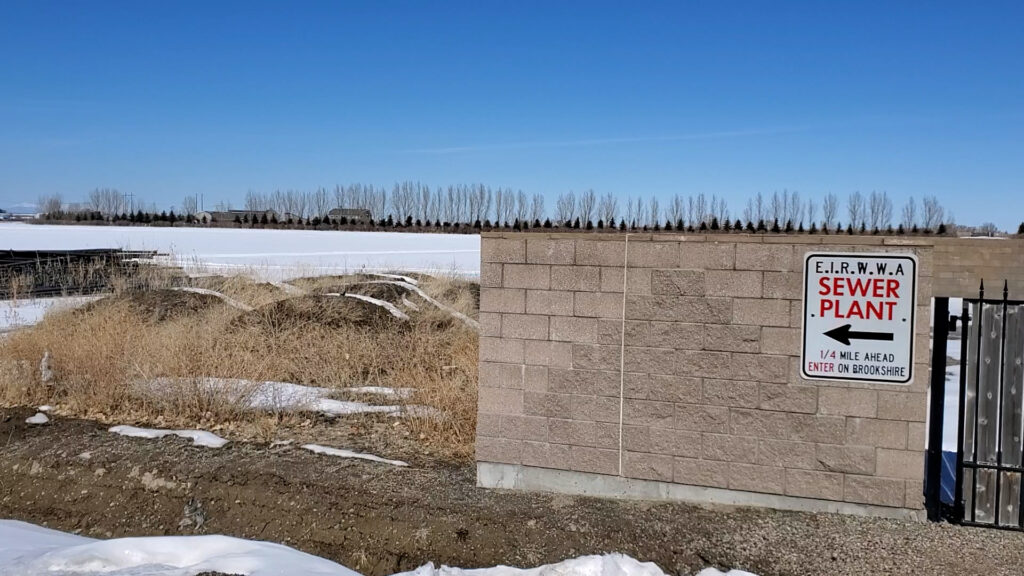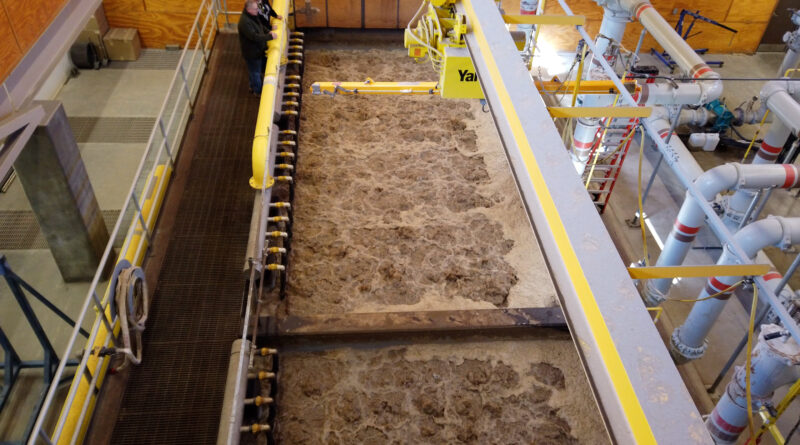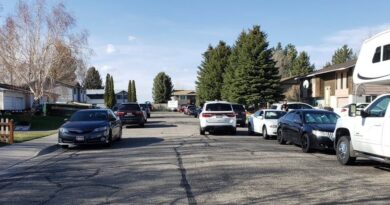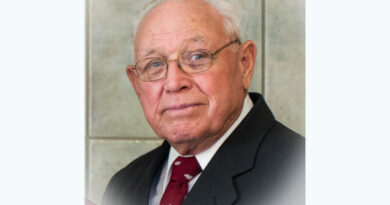Poop processing plant reaching peak proportions
SHELLEY – For 10 years, poop from Shelley, Ammon, and Exit 113 has flowed to East Idaho Regional Wastewater Authority’s plant, located west of Shelley. However, this flow is reaching peak capacity, forcing the authority to find an equitable way for all involved to process the waste.
HOW IT ALL BEGAN
In January of 2000, interested parties from areas east and south of Idaho Falls met to investigate the feasibility of collecting and treating wastewater on a regional basis. The motivating factors were managing high growth in unincorporated county areas and developing a system that could inexpensively treat wastewater as more homes tied into the system based on its economy of scale.
The parties who met together included the cities of Ammon and Shelley, the Iona Sewer District, and the counties of Bonneville and Bingham.
THE PROPOSAL AND PROJECTS
The parties hired Forsgren Engineering out of Rexburg, who proposed a three-phase plan with each of the five political entities sponsoring a portion of the project. The projects were as follows:
- Project 1 – Northern Interceptor: (Sponsor-Bonneville County) A transmission main to collect flows from the New Sweden Exit 113 on Interstate 15 (including the Melaleuca world headquarters) and the unincorporated community of Woodville and convey the flow by gravity and a central lift station.
Bonneville County acted as the sponsor for the design and construction of this interceptor. Melaleuca, who had intentions of constructing their headquarters in the area, joined Andrus Brothers Trucking, putting up $1.4 million towards the design and installation of the sewer line conveying their flow to Shelley. In return, they were entitled to a portion of all hookup fees along the line they financed. Melaleuca also received approximately 584 sewer connections known as ERUs.
- Project 2 – Eastern Idaho Regional Wastewater Treatment Plant: (Sponsor- City of Shelley) A new mechanical treatment plant to be constructed at Shelley’s wastewater old treatment lagoons, a 22-acre tract of land, west of the city along the river.
Shelley constructed the new mechanical plant on the west side of the old treatment lagoons. It was designed to treat anticipated flows from the new regional collection sites. The citizens of Shelley authorized the design and construction of the initial process flow train by approving a bond in November 2004 for $8 million.
The new facility anticipated flows of 1.5 to 2.0 million gallons per day. The plant was designed as a “Class A” processing facility allowing its treated wastewater to flow into the river or be used as irrigation water on certain types of crops or lawn areas of parks, golf courses, etc.
- Project 3, Phase 1 – Eastern Interceptor: (Sponsor – City of Ammon) A large transmission main to intercept the existing flows from Ammon and IBSD, near the intersection of Sunnyside Road and 25th East (Hitt Road) and convey them to the City of Shelley through a 48-inch, gravity-flow transmission line.
- Project 3, Phase 2 – Eastern Idaho Wastewater Treatment Plant Expansion: (Sponsor-City of Ammon) An expansion in the capacity of Shelley wastewater treatment plant to accept flows from Ammon and areas located between Ammon and Shelley.
In February 2005, Ammon authorized a bond for $23,000,000 to support their participation in the project. This cost covered installing the Eastern interceptor between Ammon and Shelley and installing a second process flow train at the facility.
The plant was constructed and designed to immediately handle 2 MGD with a future capacity of 3 to 4 MGD based on the maximum daily flow anticipated over the next 20 years.
The project was moving forward smoothly until IBSD decided to back out of the project. Their departure left the remaining partners scrambling to find sufficient funding and participants to make the project feasible.
Despite these problems, the four remaining partners of EIRWWA (Ammon, Shelley, Bonneville County, and Bingham County) decided to move forward with the plant’s construction.
OPERATIONS BEGIN

In 2009, the plant was completed, and Shelley began to process its wastewater at the facility. In 2012, Ammon completed the Eastern interceptor, and their wastewater began to flow to the plant. Once combined, the facility processed approximately 1.3 to 1.4 MGD.
In 2016, the homeowner’s association at the Country Club Golf Course joined EIRRWA by extending a line west from its development to the East Interceptor line along Country Club Road near Taylor.
REACHING PEAK CAPACITY
As development continued throughout the area, the level of wastewater has increased at the plant. Today, the plant is processing an average of 1.6 MGD. This flow is 80 percent of capacity or 2 MGD, according to Alan Giesbrecht, PE at JUB Engineering.
EIRWWA is preparing to expand the size of the plant to 4.0 MGD. This expansion is estimated to cost around $34 million. This cost is double what a plant feasibility study said it would be in 2015.
INEQUITABLE POSITION
The funding for this upgrade comes primarily from new development. Each time a new dwelling or commercial building connects to the sewer, a hookup fee is required. This fee is the cost required to replace the lost unit of sewage capacity because of that new development.
The problem is that the cost of upgrading the plant may be more than the hookup fees obtained by the cities and counties from new development in their area. The cost of new construction has escalated in the past two years because of inflation and COVID-related supply chain issues.
Although Ammon, Shelley Bingham, and Bonneville are equal partners in EIRWWA, only Ammon and Shelley can bond for an upgrade at the plant. Bonneville and Bingham Counties have no bonding capability even though each owns one-fourth of the plant.
SEWER DISTRICT PROPOSAL
EIRRWA is proposing the creation of a sewer district to eliminate the inequitable position of Ammon and Shelley. Once created, a sewer district would require landowners, both within the county and the city, who are within the new district’s boundary to pay for possible upgrades at the plant.
The authority is working to put this measure on the ballot for May 2022. However, this proposal requires signatures from 10 percent of all property owners within the proposed sewer district.
The boundary of the proposed district includes those areas of Ammon that are currently served by EIRWWA and the properties with the city limits of Shelley. It also includes properties within 300 feet of the North and East interceptor lines as they bisect Bingham and Bonneville Counties. Finally, it includes areas within both counties that have already hooked onto the EIRWWA system but are more than 300 feet from its lines.
“I am asking all of the property owners in Shelley to sign this petition so they are not held financially responsible for people living outside the cities,” Shelley Mayor Stacey Pascoe said. “Without a district, people living in the county would likely benefit freely from upgrades at the plant without having to bear the expense.
At present, Bingham County has only a handful of residential homes connected to the sewer. However, it has approved several significant home developments near Woodville and northeast of Shelley that connect to the sewer.
“The sewer district will benefit citizens within the city and the county with more effective representation than does the current entity,” Ammon Mayor Sean Colletti said. “When board members of an entity are focused solely upon a single issue, like sewer, they will provide a much better operating system.”Â
The cities and counties are not the only ones who think EIRWWA should become a district. The Idaho Department of Environmental Quality is also demanding the entities establish a district. DEQ has made it a mandate in their permit requirement for the cities and counties going forward.
Editor’s Notes: Jeff Kelley sits on the East Idaho Regional Wastewater Authority board as a representative for the city of Shelley. He has been a member of that board since Nov. 2017.






